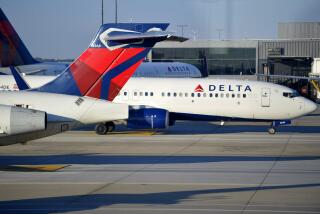It’s Time to Start Pulling Over Pilots
- Share via
They always look so good walking down the long corridors in airline terminals. Wearing their blue uniforms with all that silver braid, they exude authority, calm and confidence.
They are airline pilots. They are the people we entrust with our lives and the lives of our loved ones.
And next time I see one, I am going to wonder just one thing: Just how drunk is this guy?
That’s because Northwest Airlines recently fired three pilots for allegedly flying while legally intoxicated.
According to federal officials, the captain of a Northwest flight had a blood alcohol level greater than 0.1%, which means that in most states he was too drunk to drive a car, let alone fly a jet airliner.
According to Rep. James L. Oberstar (D-Minn.), who is chairman of the House Public Works and Transportation Committee’s Subcommittee on Aviation, the pilot “had a history of driving under the influence.”
A 1986 Department of Transportation study found that 1,000 to 2,000 pilots of commercial passenger planes had been convicted of drunk driving in the preceding 26 years.
The Northwest pilot climbed into the cockpit of a Boeing 727 in Fargo, N.D., on March 8 and took off with 91 passengers en route to St. Paul, Minn. He landed safely there, and he and his first and second officers were arrested.
The latter two were also tested for alcohol and found to have levels in excess of 0.04, which exceeds the federal limit for flying.
The FAA had been alerted to the alleged drinking by an anonymous caller, who said the crew had been drinking in a Fargo restaurant called The Speakeasy.
The caller reportedly said the crew had been drinking for more than six hours until about midnight, which was 6 1/2 hours before they took off from Fargo. Federal rules prohibit drinking within eight hours of flying, and Northwest rules prohibit it within 12 hours.
An FAA official confronted the crew, which reportedly denied drinking. After observing the crew, the official then let them take off.
Some say he should not have allowed this, and he did have the power to stop the flight. But local laws regarding drunk pilots can be pretty screwy.
In North Dakota, for instance, the law doesn’t permit the arrest of a drunk person until he is in control of a vehicle. In other words, local police would have had to allow the crew to taxi the plane before pulling it over and arresting the crew.
There is now a lot of finger-pointing going on. Some say the FAA should be praised for catching the three, others say the FAA should be criticized for letting them take off in the first place.
But the incident did reveal one glaring omission in federal regulations: While pilots can be tested for drug abuse, they cannot be tested for alcohol abuse.
The U.S. Senate has voted a number of times to allow alcohol testing for pilots and other transportation workers, but the bill has always been killed in the House.
Now, Sens. John C. Danforth (R-Mo.) and Ernest F. Hollings (D-S.C.) are trying again. Their bill would require the random testing of airline pilots and other transportation workers. It has passed the Senate and is once again before the House.
The airline pilot’s union opposes it, and the union has a point: There have been only 16 airline accidents since 1983 that have been linked to alcohol or drug use on the part of pilots. And nobody likes the idea of random testing.
But the drug and alcohol problem in America is such that random testing of certain professions has become inevitable.
In Kansas City in September, 1986, the FAA got an anonymous tip from a person saying he was at a party with a bunch of air traffic controllers who were taking drugs. Drug tests were done on 36 controllers and five were suspended for cocaine and marijuana abuse.
In 1987, there were 41 railroad accidents in which one or more rail employees tested positive for drugs after the accidents. In those accidents 29 people died, 341 were injured and more than $28 million in property damage was done. Today, rail employees can be tested for both drug and alcohol abuse.
Random testing goes against our grain. Most of us think nobody should be singled out for testing unless there is reason to believe he has done something wrong.
But harsh reality has taught us--as in the Chase, Md., Amtrak crash in which 16 people died--that we can’t wait until after disasters happen to test the crews for drug or alcohol use.
This week I spoke to Department of Transportation spokesman David Prosperi, who said Secretary of Transportation Sam Skinner is not waiting for Congress to act. He has already begun a process that may lead to the random alcohol testing of pilots, airline mechanics, bus drivers and truck drivers.
We are not talking about the persecution of people with drinking problems. Almost all employers, including airlines, have programs to help employees with drinking and drug problems.
If a pilot has a drinking problem and goes to his employer, he is not fired. He is helped. And after he has his drinking problem taken care of, he is allowed to fly again.
Sometimes, however, random testing is the only way to persuade people to seek help.
Driving drunk is bad enough. But drunk flying is too scary to tolerate.
More to Read
Sign up for Essential California
The most important California stories and recommendations in your inbox every morning.
You may occasionally receive promotional content from the Los Angeles Times.













